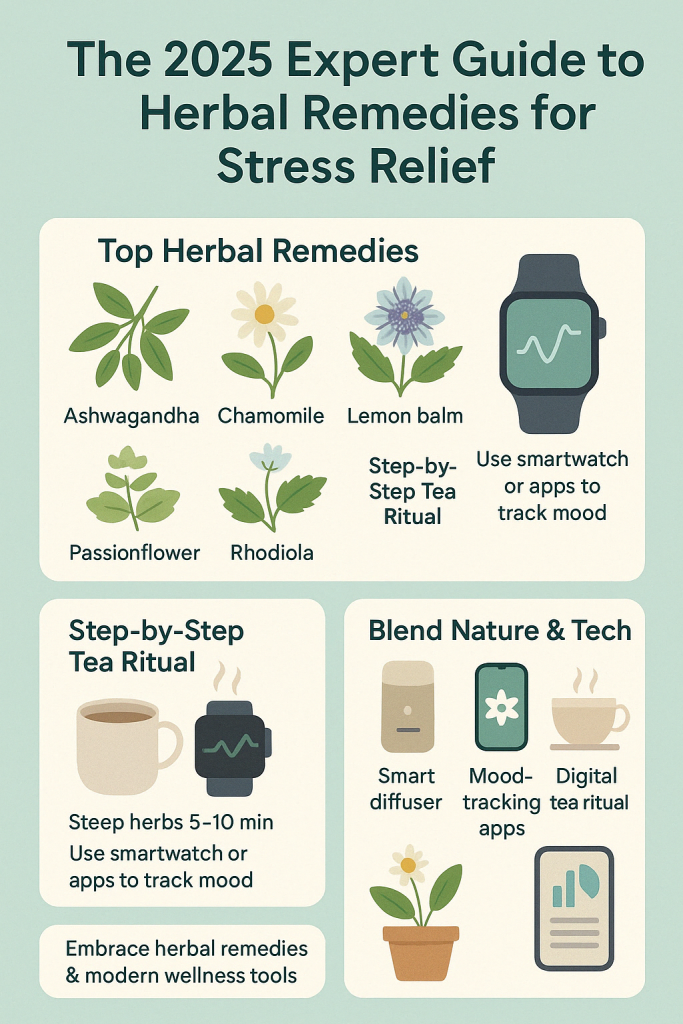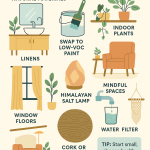🌱 My Personal Journey With Herbal Stress Relief
Let me start with a quick story.
Back in 2023, my stress levels were off the charts: remote work, endless notifications, and sleepless nights. I tried breathing exercises and meditation apps, but nothing truly clicked—until I discovered herbal remedies.
Two years later, I’m not only calmer but feel more in control, thanks to a daily routine that blends time-tested herbs and smart tech for monitoring stress. If you’re feeling anxious or overwhelmed, I promise: these natural methods are worth a try.
🏆 Why Herbal Remedies Lead the 2025 Wellness Trend
A recent Global Wellness Institute report shows that over 60% of adults now prefer herbal options for stress. The 2025 trend is about integrating natural solutions with personalized, tech-powered tracking for best results.

🌿 Step-by-Step Guide: How to Use Herbal Remedies for Stress Relief
1. Pinpoint Your Stress Triggers
- Tools: Use a smartwatch (like Apple Watch or Fitbit) to monitor your heart rate and stress notifications throughout the day.
- Tip: Log your most stressful moments in a digital journal app.
2. Choose Your Herbal Allies
| Herb | Best For | 2025 Trend Note |
|---|---|---|
| Ashwagandha | Anxiety, fatigue | Popular in adaptogen blends |
| Chamomile | Sleep, relaxation | Used in bedtime gummies |
| Lemon Balm | Mild stress, focus | Often paired with CBD |
| Passionflower | Overthinking, calm | Trending in calming teas |
| Rhodiola | Burnout, energy | Common in nootropic stacks |
3. Prepare Your Herbal Remedy
- DIY Tea:
- Add 1 tsp dried chamomile and 1 tsp lemon balm to a mug.
- Pour over 250ml hot (not boiling) water.
- Steep for 5–7 minutes. Strain and enjoy.
- Modern Tech Twist:
- Use a smart kettle for precise temperature.
- Sync your tea break with mindfulness reminders on your phone.
4. Track Your Progress
- Wearables: Check how your HRV (heart rate variability) improves after consistent use.
- Apps: Use a mood-tracking app (like Daylio or Moodfit) to log daily stress and energy.
5. Create a Nightly Herbal Ritual
- Brew your herbal blend 30 minutes before bed.
- Pair with low-blue-light tech (like a Kindle with night mode).
- Try “Sleep Stories” with relaxing herbal soundscapes from apps like Calm.
💡 Pro Tips for Blending Nature & Tech
- Smart Diffusers: Program with calming scents (lavender, bergamot) to switch on as you wind down.
- Herbal Subscription Boxes: Monthly deliveries ensure you always have fresh, high-quality herbs—many with QR codes for sourcing info and AI-personalized recommendations.
- AR Plant ID Apps: Instantly identify herbs in your local area using your phone’s camera.
❓ 9 FAQ: Herbal Stress Relief in 2025
1. Are herbal remedies safe for everyone?
Most are, but check with your doctor if you’re on medication or pregnant.
2. How long until I notice results?
Some herbs (like chamomile) work within 30 minutes; adaptogens (like ashwagandha) may take a week or two.
3. Can I combine different herbs?
Yes! Many blends are more effective, but avoid overdosing.
4. Do I need special equipment?
A teapot and strainer work fine, but smart kettles and diffusers add convenience.
5. Are supplements as good as tea?
Capsules are convenient, but teas often work faster and help you unwind.
6. Is there a best time of day to use herbs?
Daytime for energizing blends (like rhodiola), evening for calming blends (chamomile, lemon balm).
7. Can I use herbs with prescription medication?
Consult your healthcare provider first—some herbs interact with medications.
8. How do I know if herbs are high quality?
Look for third-party lab-tested brands, organic certification, and good reviews.
9. What’s the future of herbal remedies?
Personalized, AI-driven recommendations based on your biometric data and stress patterns!
📌 Final Takeaway
The biggest 2025 wellness trend isn’t just using herbs—it’s combining the best of nature and technology for personalized, effective stress relief.
My advice: start small, log your journey, and let both plants and pixels guide you to calm.

